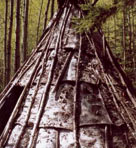  |
|
| |
Aboriginal Law > Basics |
| |
|
| |
Go to: |
| |
Who are the Aboriginal peoples of Canada? |
| |
History of Canada-Aboriginal relations |
| |
Whose law is it? |
| |
The myth of racism in Aboriginal policy |
| |
General references on Aboriginal law |
| |
|
| |
|
| |
Who are the Aboriginal peoples of Canada? |
| |
"There are two major groups of “Aboriginal people” (as defined by Sec. 35 of the Constitution Act, 1982) involved in forest lands and resources issues in Canada: “Indians” (those who are registered as Status Indians under the Indian Act) and Metis. If you’re confused about terminology, you’re not alone! The Dept. of Indian Affairs and Northern Development has a useful website to add to the confusion. See “Words First: An Evolving Terminology Relating to Aboriginal Peoples in Canada” (2002) at http://www.ainc-inac.gc.ca/pr/pub/wf/index_e.html" (quoted from P. Smith, 2005) |
| |
|
| |
|
| |
History of Canada-Aboriginal relations |
| |
A brief history will be posted here in the future |
| |
A longer history is available in the report of the Royal Commission on Aboriginal Peoples, Volume 1. |
| |
Also see the Institute on Governance's Summary of the final report of the Royal Commission on Aboriginal Peoples |
| |
|
| |
|
| |
Whose law is it? |
| |
The customary law of Aboriginal Peoples has been upheld as "law" in the Supreme Court of Canada.
It is "a basic doctrine of Western law to the effect that disparate peoples have a fundamental right to use and be governed by their own law. It comes from Roman law and echoes down the ages in several declarations." See the Native Law Centre of Canada for more. |
| |
Aboriginal rights and interpretative responsibility (Innes 1997) |
| |
This article questions the doctrine of "legal closure", which assumes that law and its practitioners can be separated from the cultural, political, and social circumstances of their historical moments. This doctrine has historically limited the range of "acceptable" interpretations of Aboriginal rights. However, if we suspend the assumptions that make up the doctrine, the role of the courts and the law appears in a light of interpretation, rather than as a quasi-mechanical application of precedents and procedures. In this light, we see a possibility for acknowledging and accommodating deep differences between Aboriginal Peoples and non-Aboriginal Peoples. |
| |
|
| |
|
| |
The myth of racism in Aboriginal policy |
| |
Critics often question Aboriginal policies such as Fisheries and Oceans Canada's Aboriginal Fisheries Strategy as being racially based. In many cases this is a distortion of reality and a misrepresentation of the true rationale and obligations that such policies attempt to address. This position is supported by the June 8, 2006 decision of the B.C. Court of Appeal in the case of Regina v. Kapp. Click here for a summary of the decision. |
| |
Another perspective is that "history" is behind the rights and claims that some characterize as racist. Click here for an article on this topic:
B.C. history, not race, fuels fishing decisions (Jan. 2, 2007). |
| |
|
| |
|
| |
General references on Aboriginal Law |
| |
Issac, T. 2004. Aboriginal Law: Commentary, Cases, and Materials. Third Ed. Saskatoon, SK: Purich.
|
| |
This is one of the most comprehensive and up-to-date resources on the subject. The text includes extensive excerpts from key cases. |
| |
Aboriginal and resource based economic development: An overview of recent trends and their implications for the business lawyer (Adkins and Neville 2001) |
| |
The authors are affiliated with Thompson, Dorfman, and Sweatman Barristers and Solicitors. |
| |
|
| |
|
| |
|
| |
|
| |
|
| |
|
| |
|
| |
|
| |
|


